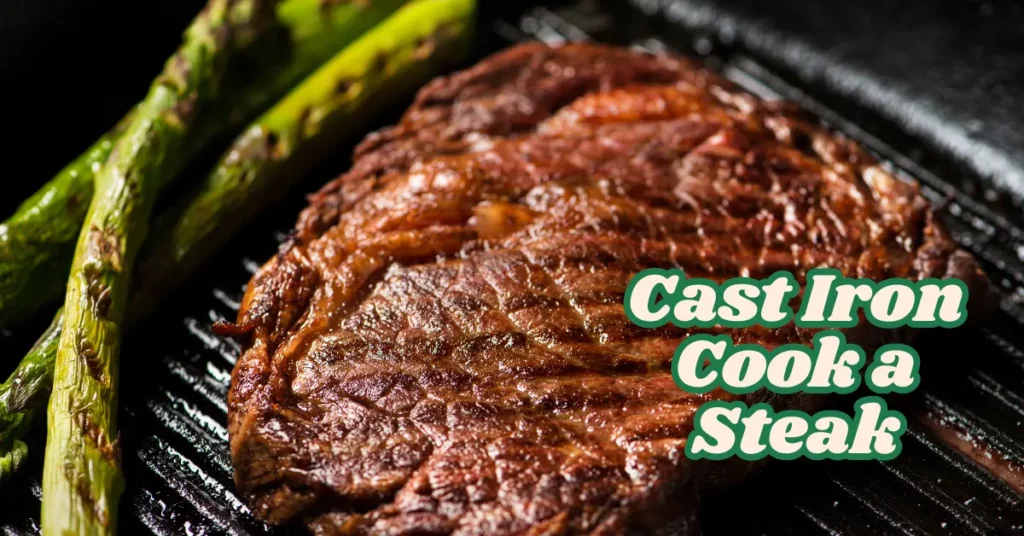This post may contain affiliate links. If you use these links to buy something we may earn a small commission. Thanks.
Few culinary experiences rival the satisfaction of cutting into a perfectly seared, juicy steak. Whether you’re a seasoned cook or a home chef learning the ropes, one of the most reliable tools in your kitchen arsenal is a cast iron skillet. Its unparalleled heat retention and ability to develop a beautiful crust make it the ideal cooking surface for steak.
In this comprehensive guide, we’ll walk you through everything you need to know about cooking steak in a cast iron skillet from choosing the right cut to achieving the perfect doneness, and finally, how to clean your pan like a pro.
Benefits of Cooking Steak in a Cast Iron Skillet
Before we dive into the process, let’s explore why cast iron is such a popular choice for cooking steak:
1. Even Heat Distribution
Cast iron heats evenly and maintains high temperatures consistently, which is essential for searing the steak and locking in juices.
2. Restaurant-Quality Crust
That golden-brown, flavor-packed crust you get in a steakhouse? It’s called the Maillard reaction, and cast iron excels at creating it.
3. Stove-to-Oven Versatility
You can easily start your steak on the stovetop and finish it in the oven without switching pans—making cast iron perfect for thicker cuts.
4. Enhances Flavor Over Time
With proper care, a seasoned cast iron skillet improves over time, adding subtle flavor layers to every dish you cook.
Choosing the Right Cut of Steak
Not all steaks are created equal, especially when you’re aiming for cast iron perfection. Here are some top choices:
- Ribeye – Rich marbling, tender, and flavorful.
- New York Strip – A nice balance of tenderness and chew with great flavor.
- Filet Mignon – Extremely tender, though leaner.
- T-bone or Porterhouse – A combination of filet and strip, ideal for hearty appetites.
Thickness Matters
Aim for steaks that are at least 1 to 1.5 inches thick. Thinner steaks cook too quickly and may overcook before a good sear develops.
Marbling Is Key
Look for steaks with visible fat marbling. Fat renders during cooking, adding moisture and flavor.

Prepping the Steak
Preparation is just as important as the cooking process. Here’s how to get your steak ready:
Bring It to Room Temperature
Take the steak out of the fridge at least 30–45 minutes before cooking. This ensures even cooking from edge to center.
Pat It Dry
Moisture is the enemy of a good sear. Use paper towels to thoroughly dry both sides of the steak.
Season Generously
Stick with the basics: kosher salt and freshly cracked black pepper. You can also add:
- Garlic powder
- Smoked paprika
- Crushed rosemary or thyme
Pro tip: Season both sides and the edges for an all-around flavor boost.
Preheating the Cast Iron Skillet
This step is absolutely critical. Your pan needs to be blazing hot before the steak hits it.
How Long to Preheat?
Heat your cast iron skillet on medium-high heat for 5–10 minutes. You’ll know it’s ready when a drop of water sizzles and dances on the surface.
Use the Right Oil
Choose an oil with a high smoke point, such as:
- Avocado oil
- Canola oil
- Grapeseed oil
Avoid butter at this stage it burns quickly.
Cooking the Steak: Step-by-Step Guide
Now for the main event! Here’s how to masterfully cook your steak in cast iron:
1. Add Oil
Pour about 1 tablespoon of oil into the preheated skillet and swirl to coat the bottom.
2. Place the Steak
Carefully place your steak in the pan—lay it away from you to avoid oil splatter. You should hear an immediate sizzle.
3. Don’t Move It
Let the steak cook undisturbed for 2–4 minutes depending on thickness. This allows a proper crust to form.
4. Flip and Sear
Using tongs, flip the steak and sear the other side for another 2–4 minutes.
5. Add Butter and Aromatics
Add a couple of tablespoons of butter, along with crushed garlic cloves, rosemary, or thyme. Tilt the pan slightly and baste the steak with the melted butter.
6. Optional: Finish in the Oven
For thicker cuts, place the entire skillet in a 400°F oven for 5–8 minutes to finish cooking to your preferred doneness.
Cooking Time and Doneness Guide
Use a meat thermometer to avoid guesswork. Here’s a quick guide:
| Doneness | Internal Temp (°F) | Visual Cues |
|---|---|---|
| Rare | 120–125°F | Cool red center |
| Medium Rare | 130–135°F | Warm red center |
| Medium | 140–145°F | Pink center |
| Medium Well | 150–155°F | Slightly pink |
| Well Done | 160°F+ | Brown throughout |
Resting the Steak
Once cooked, resist the urge to slice immediately.
Why Resting Matters
Resting allows juices to redistribute throughout the meat, preventing them from leaking out and leaving you with a dry steak.
How Long to Rest?
Let your steak rest 5–10 minutes on a cutting board, tented with foil.
Serving Suggestions
Now that your steak is rested and ready, it’s time to serve.
Slice Against the Grain
Cutting against the muscle fibers ensures tender, bite-sized pieces.
Delicious Side Dishes
Pair your steak with classic or creative sides:
- Roasted garlic mashed potatoes
- Grilled asparagus or green beans
- Creamed spinach
- Baked sweet potato
- Compound butter or chimichurri sauce
Cleaning and Caring for Your Cast Iron Skillet
Taking care of your skillet is as important as your cooking technique.
Cleaning Tips
- While still warm, wipe off any food residue.
- Rinse with hot water and use a brush or scraper.
- Avoid soap and never soak—it damages seasoning.
- Dry thoroughly and apply a thin coat of oil before storing.
Re-seasoning the Skillet
If your pan looks dull or patchy, re-season it:
- Coat with a thin layer of oil.
- Bake upside down in a 450°F oven for 1 hour.
- Cool in the oven before storing.
Troubleshooting Common Mistakes
1. Steak Sticks to the Pan
The skillet wasn’t hot enough. Always preheat fully before adding meat.
2. Too Much Smoke
Use high smoke point oils and avoid butter during initial sear.
3. Uneven Cooking
Use a thermometer and finish in the oven for thicker cuts.
4. Overcooking
Pull the steak off the heat 5°F before your target temp it continues to cook while resting.
Conclusion
Cooking steak in a cast iron skillet isn’t just a method it’s a culinary ritual. The sizzling sear, the aromatic butter basting, and the final slice into a juicy, perfectly cooked piece of beef are all part of the experience. With the right cut, proper technique, and a bit of patience, you can achieve steakhouse-quality results right in your own kitchen.
So fire up that cast iron skillet and treat yourself you’ve just unlocked the secret to steak perfection.
